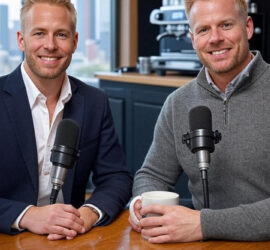Professional Email
Etiquette Essentials
This practical course teaches you how to write polished, professional emails that make the right impression. You'll learn the key components of formal email structure and discover when and how to use appropriate openings, sign-offs, and closings in American English business communication.

Email Formality Matters
Learn to navigate the spectrum of email formality and choose the right style for every professional relationship and situation.
Professional Email Skills Course
Welcome to this course on professional email communication! Throughout these lessons, you’ll develop essential skills to enhance your email effectiveness in various workplace contexts.
What You’ll Learn
In this course, we’ll cover:
- Distinguishing between different email formality levels
- Crafting appropriate openings and greetings
- Writing effective sign-offs and closings
- Adapting your style to different professional relationships
Let’s start by exploring how to recognize and use different levels of email formality.
Types of Emails
Email communication typically falls into three distinct formality levels, each appropriate for different professional relationships:
Formal Emails
- Use standard letter-writing style
- Include proper titles and surnames
- Feature structured openings and closings
- Maintain professional language throughout
Semi-Formal Emails
- Balance professionalism with approachability
- Use first names with “Dear”
- Include friendly but professional sign-offs
- Mirror the correspondent’s style
Informal Emails
- Use casual greetings or first names only
- Feature relaxed language and structure
- Include brief, friendly closings
- Sometimes omit formal elements entirely
Formal Emails in Action
Formal emails serve specific purposes in professional communication and are especially important in certain contexts:
Appropriate Situations
- First-time communications between individuals or organizations
- Writing to someone whose name you don’t know
- Contacting companies or organizations officially
- Communications requiring professional distance
Key Characteristics
- Openings: “Dear Sir/Madam” or “Dear Mr./Ms./Dr. [Last Name]”
- Closings: “Yours faithfully” (British) or “Sincerely” (American)
- Sign-off sentences referring to future contact
-
Polite, complete sentences with formal vocabulary
How Relationships Shape Formality
Formal Relationships
- New business contacts
- Unknown recipients
- High-ranking officials
- External organizations (first contact)
- Situations requiring professional distance
Semi-Formal Relationships
- Colleagues who haven’t met in person
- Different organizations with established relationships
- Different levels within same organization
- After first meetings with new contacts
- Professional relationships with some familiarity
Informal Relationships
- Close co-workers
- Team members who interact regularly
- Some manager-employee relationships (company culture dependent)
- Long-established professional relationships
- Internal communications in casual workplace cultures
Email Formality in Action
Let's explore some common scenarios and identify the appropriate formality level for each. Check your understanding of when to use formal, semi-formal, or informal email styles.
Test Your Understanding
Let’s check your understanding of email formality levels and when to use them. Consider the following scenario and select the most appropriate approach:
- Formal email with “Dear Mr./Ms. [Last Name]” and a professional closing
- Informal email with just “Hi [First Name]” and a casual tone
- Semi-formal email with “Dear [First Name]” and friendly language
- No greeting, just get straight to the point with your request
When contacting someone at a higher level whom you’ve never met, formal style is appropriate to show respect and professionalism.
Wrong! 2. Informal email with just “Hi [First Name]” and a casual tone
This is too casual for a first contact with someone at a higher level in the organization whom you’ve never met.
Wrong! 3. Semi-formal email with “Dear [First Name]” and friendly language
While semi-formal might be appropriate after you’ve established a relationship, a first contact with a higher-level colleague typically calls for formal style.
Wrong!
4. No greeting, just get straight to the point with your requestOmitting greetings entirely is only appropriate in very informal, ongoing exchanges between close colleagues.
Perfect Your Email Greetings
Master the art of professional email openings with the right greetings, titles, and formatting conventions in American English.
Formal Greetings: Known Recipients
When you know your recipient’s name, you’ve got a few professional options for your greeting line:
With Last Name:
- Dear Mr. Thomas
- Dear Ms. Thomas
- Dear Dr. Thomas
With Full Name:
- Dear John Thomas
Notice how each greeting starts with “Dear” followed by the appropriate title and name. This format maintains professionalism while acknowledging the recipient personally.
In modern business communication, you might also use just the first name with “Dear” (Dear John) in situations where you have an established relationship but still want to maintain some formality.
Title Abbreviations in American English
In American English, title abbreviations in email greetings typically include a period (full stop). This small detail can make a big difference in how professional your email appears.
Let's look at the correct formatting for common titles in American English email openings:
Correct Format
- Mr. (for men)
- Ms. (for women, regardless of marital status)
- Dr. (for those with doctoral degrees)
- Prof. (for professors)
Modern Usage Note
In contemporary business communication, “Ms.” is increasingly preferred over “Mrs.” (married woman) or “Miss” (unmarried woman).
Using “Ms.” avoids making assumptions about a woman’s marital status and is considered the most professional option
Formal Greetings: Unknown Recipients
When you don’t know your recipient’s name, your options become more limited, but clarity is key:
Standard Formal Opening:
- Dear Sir or Madam
- Dear Sir / Madam
This traditional greeting is the go-to option for formal emails to unknown recipients or organizations. While it might feel a bit old-fashioned, it remains the standard in professional American English when you can’t personalize your greeting.
Email Opening Examples
Let's practice identifying appropriate email openings for different scenarios. Flip each card to see the correct greeting format for each situation.
Capitalization in Email Greetings
Proper capitalization is essential in professional email greetings. Here are the key rules to follow:
-
Always capitalize the first word of your greeting (“Dear”)
-
Always capitalize titles (Mr., Ms., Dr., Prof.)
-
Always capitalize both first and last names
-
Always capitalize “Sir” and “Madam” in “Dear Sir or Madam”
Consistent capitalization demonstrates attention to detail and professionalism in your communication. Even in less formal emails, maintaining proper capitalization in names and titles shows respect for your recipient.
Let’s practice identifying appropriate email openings for different scenarios. Flip each card to see the correct greeting format for each situation.
dear Mr. Johnson
Dear mr. Johnson
Dear Mr. johnson
Dear Mr. Johnson
Incorrect! Dear mr. Johnson The title ‘mr.’ should be capitalized as ‘Mr.’
Incorrect! Dear Mr. johnson The last name ‘johnson’ should be capitalized as ‘Johnson’.
Correct! Dear Mr. Johnson This greeting properly capitalizes the first word, the title, and the recipient’s name.
Incorrect! dear Mr. Johnson The greeting “dear” should be capitalized as “Dear.”
Craft Professional First Impressions
Your email greeting sets the tone for your entire message. For professional communication, use "Dear Mr./Ms./Dr. [Last Name]" when you know the recipient, and "Dear Sir or Madam" when you don't. In American English, always include periods after title abbreviations (Mr., Ms., Dr.) and capitalize titles and names properly. Remember that Ms. is now preferred for addressing women in professional contexts, regardless of marital status. These small details demonstrate your professionalism and attention to detail from the very first line of your email.
Writing the Perfect Email
Learn how to create professional sign-off sentences that balance friendliness with formality and effectively reference future contact in your emails.
Sign-offs vs. Closings: What’s the Difference?
When ending a professional email, there are actually two distinct elements to consider:The Sign-off Sentence
A complete sentence that makes reference to future contact, appearing just before your closing. It serves as a friendly transition between your message and your name.The Closing
A brief expression (like “Sincerely” or “Best regards”) that appears immediately before your name. Many people focus only on the closing and forget the sign-off sentence entirely. Yet this final sentence is your last chance to sound both friendly and professional while keeping the conversation going.Why Sign-offs Matter
Sign-off sentences are especially useful in formal and semi-formal emails as they soften the formality while maintaining professionalism.Referencing Future Contact
Professional sign-off sentences often reference future contact in one of these ways:Inviting Further Discussion
“If you are interested in discussing this further, please contact me using the details below.”Offering Assistance
“Please call me at any time if there is anything else you would like to know.”Confirming Plans
“I look forward to seeing you next month.” (when a meeting is already arranged)Suggesting Next Steps
“Do you think that we could arrange a phone call to discuss it further? What would be a good time for you?” These sentences create a natural bridge between your email content and your closing, while keeping the door open for continued communication.Balancing Formality and Friendliness
The perfect sign-off strikes a balance between being professional and approachable. Your choice depends on your relationship with the recipient and the context of your email.Consider These Factors:
- How well do you know the recipient?
- What's the purpose of your email?
- What's the organizational culture?
- Have you communicated with this person before?
Formal Contexts
- “If you are interested in discussing this further, please contact me using the details below.”
- “Please call me at any time if there is anything else you would like to know.”
- “I look forward to our meeting on Thursday.”
Semi-formal Contexts
- “Please email or call me if you would like to discuss this further.”
- “Do you think that we could arrange a phone call to discuss it further?”
- “By the way, I will be in Chicago again in June. Maybe we could meet up again then?”
- “Please give me a ring if there is anything else you would like to know.”
Effective Sign-offs in Action
Let's look at some effective sign-off sentences for different scenarios. Each card shows a situation on the front and an appropriate sign-off on the back. [/su_column]
[/su_column]
Common Sign-off Mistakes
Even experienced professionals sometimes make mistakes with their email sign-offs. Let’s test your knowledge about a common misconception:
Correct! FALSE
A sign-off sentence and a closing statement serve different purposes. The sign-off is a complete sentence that references future contact and appears before the closing, while the closing is a brief expression.
INCORRECT! This statement is actually false. A sign-off sentence and a closing statement serve different purposes in an email. The sign-off is a complete sentence that references future contact and appears before the closing, while the closing is a brief expression that appears immediately before your name.
Test Your Sign-off Skills
Now that we’ve covered the essentials of effective email sign-offs, let’s test your understanding with a quick quiz.
Remember that a good sign-off sentence should:
-
Reference future contact appropriately
-
Match the formality level of your email
-
Sound friendly yet professional
-
Appear before your closing statement
- If you are interested in discussing this proposal further, please contact me using the details below.
- Give me a ring if you want to chat more about this.
- I’ll call you next week to follow up.
- Thanks for your time.
CORRECT
If you are interested in discussing this proposal further, please contact me using the details below.
INCORRECT: Give me a ring if you want to chat more about this.
This sign-off is too informal for a first contact with a potential business partner. Phrases like ‘give me a ring’ and ‘chat’ are better suited for semi-formal or informal emails.
INCORRECT: I’ll call you next week to follow up.
This sign-off assumes too much and doesn’t give the recipient a choice about future contact, which can seem presumptuous in a first email to a potential business partner.
INCORRECT: Thanks for your time.
While polite, this is more of a closing statement than a sign-off sentence. It doesn’t reference future contact, which is an important element of an effective sign-off sentence.
Key Takeaway
Crafting Sign-offs That Work
Remember that effective email sign-offs serve as a bridge between your message and your closing. They should reference future contact in a way that's appropriate to your relationship with the recipient and the context of your email. By including a thoughtful sign-off sentence before your closing, you'll sound both professional and approachable, leaving a positive final impression. In your next email, try using phrases like "Please contact me if you need any further information" or "I look forward to your response" to keep the conversation going in a professional manner.
Formal Closings for American Business
In highly professional or corporate settings, your email closing should reflect the formality of the situation. American English has specific conventions for formal correspondence.
Top Formal Closings
Sincerely – The gold standard for formal American business emails, especially when writing to someone whose name you know.
Regards – A versatile formal closing that works well in most professional contexts.
With very best wishes – Slightly warmer while maintaining professionalism, good for ongoing formal relationships.
Remember, formal closings work best when paired with formal openings (like “Dear Mr. Smith”) and content that maintains a professional tone throughout.
Semi-Formal Options for Colleagues
When writing to colleagues or team members, you can often use more relaxed closings while still maintaining professionalism.
Effective Semi-Formal Closings
Best regards – A friendly yet professional option that works well for ongoing relationships.
Thanks – Commonly used even when no help was provided, often followed by another closing (“Thanks, Best regards”).
Yours – A simple, versatile closing for semSemi-formal correspondence.
These closings are perfect for emails to people you work with regularly but haven’t met, colleagues at different organizations, or people at various levels within your company.
Matching Closings to Email Formality
The closing you choose should align with the overall tone and formality of your email. Consistency creates a polished, professional impression and avoids the awkwardness of mixing formal content with an overly casual closing (or vice versa).
Choosing the Right Closing
The right email closing depends on several factors. Let's explore some common scenarios and appropriate closings for each. Flip the cards to see which closing works best in each situation.
Hello everyone, I’m Aristotle. Today I’m hoping to learn about some fundamental aspects of English grammar, specifically around how we talk about actions and possessions. I’ve invited Darwin to help explain these concepts to me.
Darwin
I’m happy to be here, Aristotle. I’m Darwin, and I’ve been studying a comprehensive English language guide that covers present tenses and possessive forms. This material is crucial for building a strong foundation in English, and I’ll try to explain it in simple terms.
Aristotle
Great! I often get confused between things like ‘He is running’ and ‘He runs.’ What’s the core difference between the present simple and the present continuous?
Darwin
That’s a common point of confusion! The guide explains it well. Think of the present simple as describing things that are always true, or true for a long time, or happen regularly. For example, ‘They walk to school every day’ or ‘They wear jeans to school.’ It’s about habits or facts.
Aristotle
So, ‘He is a healthy child’ would be present simple because it’s a general fact about him?
Darwin
Exactly! That’s a state of being, a general truth. Now, the present continuous, on the other hand, describes an activity happening right now, at this very moment, or in the near future. So, ‘He is running to school’ means he’s doing it right now. Or, ‘They’re going to a party this evening’ refers to a planned future event.
Aristotle
Ah, I see! So, ‘She jumps on the mat’ is what she generally does, but ‘She is jumping on the mat’ means she’s doing it right now. And if Ben and Ana ‘like to paint,’ that’s a general preference, but ‘They are painting a picture’ means they’re doing it at this moment?
Darwin
You’ve got it! The guide uses the example of Nick: ‘What is Nick doing? He’s playing his guitar.’ The ‘is playing’ tells us it’s happening right now. It’s the ‘am/is/are + verb + ing’ structure.
Aristotle
That makes a lot more sense. Now, let’s switch gears to possessives. I often mix up ‘whose’ and ‘who’s,’ and ‘my’ versus ‘mine.’ Can you clarify those?
Darwin
Certainly. The guide highlights these distinctions. ‘Who’s’ is a contraction of ‘who is’ or ‘who has.’ For example, ‘Who’s that?’ means ‘Who is that?’ But ‘Whose’ indicates possession. ‘Whose car is that?’ means ‘To whom does this car belong?’
Aristotle
So, ‘Who’s’ is like ‘he’s’ for ‘he is,’ but ‘Whose’ is about ownership. Got it. What about ‘my’ versus ‘mine’ and similar pairs like ‘your’ and ‘yours’?
Darwin
Excellent question. ‘My’ is a possessive adjective; it always comes before a noun, like ‘This is my dog.’ It describes the noun. ‘Mine’ is a possessive pronoun; it stands alone and replaces the noun. So, if someone says, ‘She’s not your dog,’ you can reply, ‘She’s mine.’ It means ‘my dog’ without repeating ‘dog.’
Aristotle
So, ‘my’ needs a noun after it, but ‘mine’ doesn’t. It’s the same for ‘your’ and ‘yours,’ ‘her’ and ‘hers,’ ‘our’ and ‘ours,’ ‘their’ and ‘theirs.’ Like, ‘She’s our dog’ uses ‘our’ before ‘dog,’ but ‘She’s ours’ uses ‘ours’ to mean ‘our dog.’ Is that right?
Darwin
Precisely, Aristotle! You’ve grasped the distinction perfectly. The guide emphasizes that these small words are crucial for clear communication. You can now confidently say, ‘Whose pants are these? They’re not mine! They must be yours!’
Aristotle
I think I could explain this to someone else now! The present simple is for general truths and habits, while the present continuous is for actions happening now or in the near future. And ‘whose’ is for possession, while ‘who’s’ is ‘who is.’ Finally, words like ‘my’ are adjectives that need a noun, but ‘mine’ are pronouns that stand alone. Thank you for explaining these complex topics so clearly, Darwin.
Darwin
You’ve summarized it beautifully, Aristotle. That’s exactly what makes the Feynman technique so powerful – if you can explain a complex concept in simple terms, you truly understand it. I’m glad I could help make this grammar more accessible.
Download this lesson for FREE! Click the button below:
Download Free Lesson¡Desbloquea tu Potencial en Inglés – Prueba una semana Clases GRATIS!
¿Te ha gustado nuestra rápida lección de inglés de 5 minutos? ¡Imagina lo que podrías lograr en una clase completa! Nos emociona ofrecerte una oportunidad exclusiva: ¡una clase de prueba GRATIS! Así es – experimenta todos los beneficios de nuestras lecciones envolventes sin **ninguna obligación** de tu parte.
¿Listo para dar el siguiente paso? Comienza tomando nuestro **EXAMEN DE UBICACIÓN en línea GRATIS** y descubre el nivel perfecto para ti. Esta es tu oportunidad para mejorar tus habilidades y aumentar tu confianza en inglés, todo mientras disfrutas de un ambiente de aprendizaje interactivo y de apoyo.
No te pierdas esta increíble oferta: ¡inscríbete hoy y descubre lo divertido y efectivo que puede ser aprender inglés!
Empieza aquí: Examen de Ubicación
Thank you for joining this quick lesson on 20 informal expressions commonly used in American business. Stay tuned for more bite-sized English lessons at 5-Minute English!
Happy studying!










